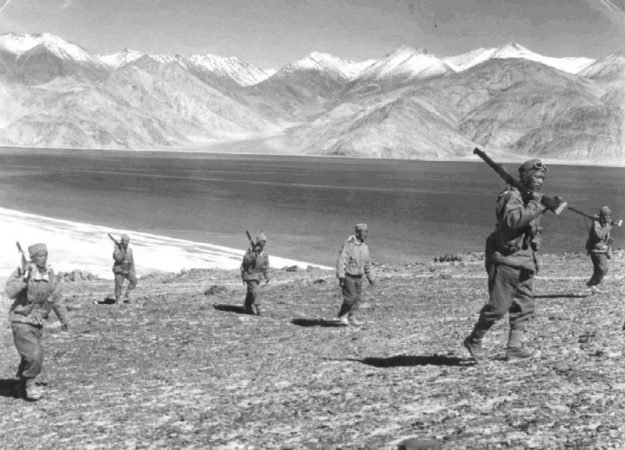The Battle of Sikkim – How India Resisted the Chinese Aggression in 1967

Nestled within the folds of the Himalayas and landlocked, the pristine federal state of Sikkim is well known for its beauty, healthy living and as one of India’s best havens for tourists. With a rich and vibrant culture, it is indeed one of the most well-performing states in India. Sikkim is surrounded by Nepal on the West, China (PR) on the North and East while Bhutan also shares a small stretch of the border. Strategically located, the independent erstwhile kingdom became a part of India on the 16th of May 1975. However, the Chinese always had their sights on this small state which would have been inimical for us in the longer run. Being expansionist in nature, the Chinese are well versed in the art of making audacious territorial claims much to the chagrin of its neighbours.
Since the foundation of the Peoples’ Republic of China in 1949, major decisions taken by the regime reflected an indigestible trail of superiority, territorial control and an aggressive nature previously unseen. Although India and China (PR) both agreed to the principles of the Panchsheel and peaceful co-existence, the Chinese were dead serious about their territorial claims on Indian territory which they perceived was remnants of the colonial British rule.

A Broken Dream
India’s dreams of a peaceful co-existence with China (PR) was shattered in 1962 but the seeds of the unforeseen aggression were already sowed when India accepted H.H. The Dalai Lama who sought refuge in India after the forcible occupation of Tibet. In 1959, the Chinese made extraordinary claims on Indian territory in Ladakh leading to a small clash between the two sides. The squabble over the issue continued with the Chinese refuting all of India’s claims calling it as a historical error on the part of the British administration.
Not only this, but the Chinese also refused to recognize the McMahon line in the Eastern sector and agreed to a compromise over Aksai Chin in return for the Eastern frontier. Thus it presented India with an ‘option’ to forego either of its interests, the McMahon line in the East or Ladakh in the West. Also, Sikkim being an independent kingdom was always on the sights of the Chinese, however, India’s firm determination to defend the small Himalayan Kingdom irked the Chinese. This exposed the Chinese strategy of primarily making audacious claims and then calling for a settlement and also employing violence and propaganda in the backdrop.
The charge of the Elephant
Stunned after the defeat at the hands of the Chinese in 1962, India took extra precautions to beef up its military preparedness, the subsequent war with Pakistan in 1965 also led to a boost in the sagging morale of the armed forces, however, the wounds of 1962 were still not healed. The Chinese by now had realised that India is a pushover, the border disputes had still not been resolved with the Chinese repeatedly intruding into Indian territories to stake their claims. In the year 1967, Sikkim was still an independent kingdom and a protectorate of the Indian Republic and with a meagre armed force, it had no power to stand up to the Chinese. The Chinese always objected to the Indian presence in an independent Sikkim often making spurious claims over it. The subsequent annexation of Sikkim in 1975 did not go unscathed either with the Peoples’ Daily churning out the harshest criticism.
One may wonder as to why the Chinese would take so much interest in Sikkim, and the answer can be found in history when Sikkim was constantly under threat by warring tribes from Nepal, Bhutan and Tibet. It went to this extent that the complete control of the British over the kingdom of Sikkim offered some semblance of defence which was then continued by India. Sikkim’s strategic location as a buffer state against Tibet was taken seriously by the Chinese after its annexation. The Chinese knew exactly that if Sikkim remained within the Indian sphere of influence then it would act as a major threat against Chinese interests in the region.
Confident after the 1962 victory, the Chinese did not see India as a force to reckon with, and in 1967 while Indian soldiers were busy fencing a section of the border between Sikkim and China (PR), the Chinese soldiers objected to what they saw was a nuisance. It must also be remembered that even during the war in 1965 with Pakistan, the Chinese had attempted to seize the Nathula pass from India only to be repulsed. Following the years, an Indian diplomat posted in Beijing, K Raghunath was termed as a spy which also soured relations between the two neighbours, and the Chinese were experts in propaganda which tried to showcase India as a threat to the peace in the neighbourhood. Added to this, the silent troop build-up by India in Sikkim and the control of the Nathula pass was not taken kindly by the Chinese.

The 1967 skirmish and a bleeding dragon
With frequent arguments from both the sides going on incessantly, the Chinese resorted to their usual bullying tactics to cow down the Indians who were in no mood to heed. During one of the heated exchanges a young lieutenant, Sheru Thapliyal broke the glasses of the Chinese Political Commissar dealing a death blow to his prestige. The Chinese responded with fire which dealt heavy causalities on the Indian side. Over the next few days, the Indian troops responded with superior fire dealing heavy causalities on the Chinese, and even in Cho La Pass, a Gurkha regiment deterred Chinese adventurism. Estimates state that while India lost around 80 soldiers, the Chinese lost anything from 300 to 400. Stunned at the unexpected response from the Indians, they retreated to their position and till date the Chinese have never tried to irk the Indians at least in this sector.
Lessons learnt
The clash between the Indian and the Chinese forces in 1967 exhibit a turn of tenacity in the Indian forces, a sense of psychological prowess and a boost in the morale. While the political brass in New Delhi is confident in dealing with Pakistan, the same confidence wanes when it comes to China (PR). The fact that the war in 1962 ended in a disaster was also a lesson, but the small victory in 1967 actually led to the Chinese non-intervention in the subsequent war with Pakistan in 1971. Declassified files display that the then American President Richard Nixon wished that the Chinese should create some pressure alongside the border with India in order to divert the attention, which the Chinese did not heed to. Perhaps, they had realised that India was no longer a nation to goad into silence.
The Chinese aggression at the border with Sikkim was reeking with over-confidence and such use of force was to psychologically browbeat the Indians, using the rhetoric of 1962 the Chinese displayed utter brazenness which ultimately made them undertake such foolhardy steps. Immediately after the conflict, it was the turn of the Chinese to be stunned beyond doubt at the sudden Indian response which they had never expected. Even in the 1965 war, the Chinese had coerced India to vacate the Jelep La pass and India did not mount any resistance. Explaining this posturing, the Chinese have a habit of making absurd claims on various territories citing historical but lapsed references, coercing the defending forces psychologically and then offering a package deal to exchange territories in possession. The net result is that the Chinese dominate the game and force the other to commit a zugzwang. Scholars agree that the Chinese tactics of bullying when does not yield results usually ends up in one-sided violent acts by the Peoples’ Liberation Army to score a point, therefore the Chinese on one hand use coercive gestures and languages and on the other violence. However, befitting response even by defending nations often send them scurrying back as it happened in the Sino-Vietnam conflict in 1979.

The Chinese never ever imagined that Indian troops would vehemently defend Sikkim which was not even a part of India in 1967, this of course exhibited the strong resolve of India to defend it strategic areas which were a vast improvement over its defeat in 1962 at the hands of the same adversary. The fact that the Indian troops stood up to China (PR), made the Chinese realise that in the Eastern sector such miscalculations would not be tolerated any longer. A similar incident occurred in Tuhung La in Arunachal Pradesh in 1975 when Chinese and Indian patrols came too close for comfort leading to crossfire. However, the Chinese contrary to all expectations did not pursue the incident any further.
Defending Nathula and Cho la not only gave India serious morale and psychological boost but also deterred further misadventures from China (PR) in the region. This is one of the reasons why the Chinese eye the Chicken’s neck and the Siliguri corridor which firmly rests with India. Caution must be however exercised in this region which is strategically important for us and the failure to do so may have severe consequences of an unprecedented nature. Nevertheless, such milestones should also be presented to showcase the prowess of the Indian Army and to suggest that effective and tactical response is a sure way to deal with the neighbourhood bully.


















